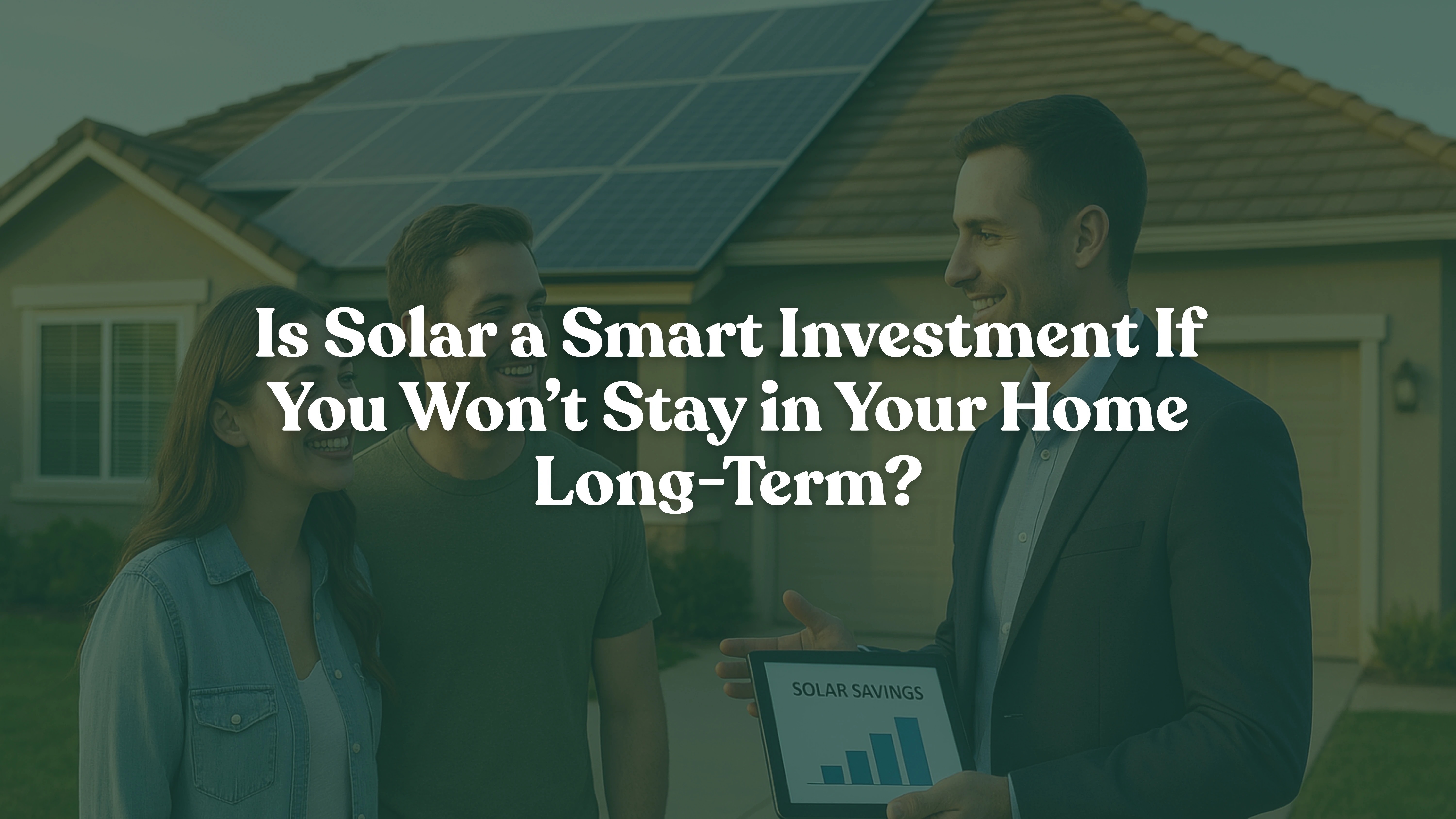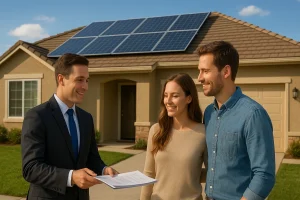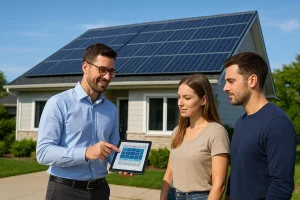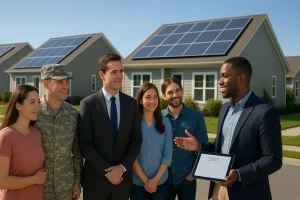Is Solar a Smart Investment If You Won’t Stay in Your Home Long-Term?

Is Investing In Solar Worth It! If You’re Not Planning To Stay In Your Home Long-Term?
Short-term homeowners face a common dilemma: With traditional solar payback periods ranging from 7-12 years, is solar investment worthwhile if you’re planning to move within 3-5 years? The answer might surprise your clients. Recent 2025 research reveals that solar installations can provide immediate value through increased property values, with homes selling for up to 6.9% more than comparable non-solar properties. Combined with rapid monthly savings and the expiring 30% federal tax credit, solar offers compelling short-term benefits that smart installers can leverage to convert hesitant prospects.
Understanding Solar ROI for Short-Term Investment Scenarios
The Traditional Payback Period Myth
Most homeowners believe they need to stay in their home for 8-12 years to see solar benefits. However, this thinking overlooks the immediate property value boost that solar installations provide. Studies show that homes with solar panels sell for 6.9% more than comparable homes without solar systems, translating to approximately $25,000-$29,000 in added value for a median-priced home.

For installers, this represents a powerful sales proposition. When a client mentions they’re planning to move in a few years, emphasize that homeowners typically see property value rise $15,000–$25,000 when they install solar panels, often recovering much of their initial investment through increased home value alone.
Immediate Financial Benefits Beyond Payback Calculations
Monthly Energy Savings Start Day One: Even short-term homeowners begin saving immediately on their electricity bills. The average solar shopper saves about $165 monthly with solar, which adds up to nearly $2,000 annually in avoided utility costs.
Federal Tax Credit Provides Instant ROI: The 30% federal tax credit offers immediate financial relief. This credit ends entirely on January 1, 2026, creating urgency for homeowners to act now. A typical $20,000 system becomes $14,000 after the tax credit, substantially reducing the net investment cost.
Home Value Appreciation: The Game-Changer for Short-Term Solar Investment
Market Data Supports Solar Premium
A 2025 Solar Reviews study found that homes with solar panels sold for 6.9% more than homes without solar panels, an increase from the 4.1% figure found by Zillow in 2019. This upward trend indicates growing buyer appreciation for solar-equipped homes.
Regional variations show even stronger returns in certain markets:
- High-electricity-cost states: Properties in states like California, New York, and Massachusetts see premium increases of 7-10%
- Eco-conscious markets: Areas with strong environmental awareness command higher solar premiums
- Hot climate regions: States with high cooling costs show increased buyer preference for energy-efficient homes
Faster Sales Velocity Benefits
There is evidence homes with solar panels sell faster than those without. For EPCs working with clients who may relocate for work or lifestyle changes, this faster market absorption reduces carrying costs and stress for sellers.
The 2025 Tax Credit Deadline: Creating Urgency for Short-Term Homeowners
Policy Changes Reshape Solar Economics
President Trump signed the “One Big Beautiful Bill” into law, and the 30% solar tax credit ends December 31, 2025. This creates a compelling deadline-driven opportunity for installers to engage short-term homeowners who might otherwise wait.

Key messaging for installers:
- Installing solar in 2025 saves homeowners an average of $9,000 compared to 2026
- Even if clients move within 2-3 years, they capture the full tax credit benefit immediately
- Post-2025 installations will face 43% longer payback periods without the credit
Market Surge Expected Before Deadline
Solar installations typically take 2-4 months from initial quote to system activation, meaning homeowners interested in maximizing their savings should begin exploring options immediately. This timeline pressure benefits installers who can fast-track installations for motivated customers.
Financing Solutions That Make Short-Term Solar Investment Attractive
Solar Loans Enable Immediate Savings
For short-term homeowners concerned about upfront costs, solar loans offer day-one savings. Assuming your monthly solar payments are less than what you currently pay for electricity, you won’t have a payback period. You’ll technically start saving in month one.
Installer advantage: Position solar loans as “replace your electric bill with a lower solar payment” rather than focusing on long-term payback calculations.
Transferable Systems Add Value
When properly financed and owned (not leased), solar systems transfer seamlessly to new homeowners. Fully owned systems are more valuable to buyers compared to leased ones, which can complicate the selling process. This transferability ensures that short-term homeowners’ investments remain intact during home sales.
System Sizing and Technology Considerations for Short-Term Investment
Right-Sizing for Maximum Value Return
Homes with larger solar systems capable of covering most of the household’s energy needs see the highest value increase. However, installers should balance system size with the homeowner’s budget and timeline constraints.

Recommended approach:
- Target 80-100% energy offset for optimal value addition
- Use high-efficiency panels to maximize production per square foot
- Consider battery backup in markets with frequent outages for additional value
Quality Equipment Matters for Resale Value
The age of the solar equipment factored into the price increase slightly. Systems over five years old sold for 5-6% more, while newer systems sold for 7-9% more. This data supports investing in quality equipment that maintains value over time.
Geographic Market Analysis for Short-Term Solar Investment
High-Value Markets for Short-Term Solar
Premium markets showing strongest returns:
- California: 5-10% home value increase in major cities
- Northeast states: High electricity rates create strong buyer interest
- Sun Belt states: Year-round production appeals to energy-conscious buyers
Market Factors Affecting Short-Term ROI
States with low electricity costs can still see a positive return from going solar, but the payback period will be extended because the utility bill you’re offsetting isn’t as steep. However, even in lower-rate markets, the property value increase often compensates for longer traditional payback periods.
Addressing Common Objections from Short-Term Homeowners
“I Won’t Be Here Long Enough”
Response strategy: Shift the conversation from payback period to immediate benefits:
- Monthly savings start immediately
- 30% tax credit provides instant return
- Home value increase of 4-7% recovers significant investment
- Faster home sales reduce market carrying costs
“What About System Maintenance?”
Buying a house with solar panels brings new owners energy savings without the upfront investment. Modern solar systems require minimal maintenance, and warranties transfer to new homeowners, making this a selling point rather than a concern.
“Will It Complicate the Sale?”
57% of real estate agents found promoting energy-efficient features in a home were somewhat valuable, and homes with solar panels sell faster. Rather than complicating sales, quality solar installations enhance marketability.
Business Opportunities for Solar Installers and EPCs
Target Short-Term Homeowner Segments
High-opportunity segments:

- Military families with planned relocations
- Corporate executives in transition
- Young professionals in starter homes
- Retirees planning to downsize
Value Proposition Messaging
Transform your sales approach by leading with immediate benefits:
- Instant savings: Replace your $200 electric bill with a $150 solar payment
- Immediate tax benefits: Get $6,000 back on your taxes this year
- Home value boost: Add $25,000 to your home’s value
- Market advantage: Your home will sell faster in today’s competitive market
The Bottom Line: Solar Investment Pays Off for Short-Term Homeowners
Solar investment for short-term homeowners offers compelling benefits beyond traditional payback calculations. With property value increases of 4-7%, immediate monthly savings, and the expiring 30% federal tax credit, installers should focus on immediate value creation rather than long-term payback narratives. The 2025 tax credit deadline creates urgency—homeowners who act now capture maximum benefits while positioning their homes as premium properties.
Energyscape Renewables provides comprehensive solar engineering solutions nationwide, offering end-to-end services from design to permitting for projects targeting short-term homeowners. To manage increased demand efficiently, Sunscape Solar’s project management software helps solar businesses streamline operations and coordinate teams for fast-paced installations before the 2025 deadline.

sjayakanth@energyscaperenewables.com